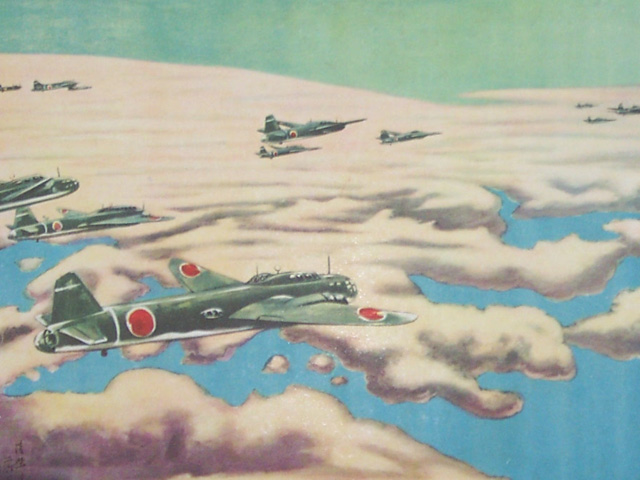
Earlier episodes of the Guadalcanal Campaign : Intro & Coral Sea, August, September
Back again to Guadalcanal. September had been a good month in terms of sunk Japanese ships, with in particular the Yamato removed from the Japanese Naval Register. Yet, I don’t feel I made much strategic progress : I did not sink any aircraft carriers, and the Japanese still have 5 battleships to harass Henderson Field.
But October, certainly, would be different, as the 7th of October I could deploy my most powerful task force yet : the Yorktown, the Saratoga and the Wasp together. I don’t think there is anything the Japanese have that can withstand such a force.
8th to 13th of October 1942 – In Search of A Lost Battleship
After leaving Brisbane on the 7th, I position my carrier fleet South of Guadalcanal on the 9th of October, waiting for an interesting prey. Meanwhile, a slow transport mission is carrying supplies for Henderson Field.
I don’t have to wait for long, a major surface fleet is detected !
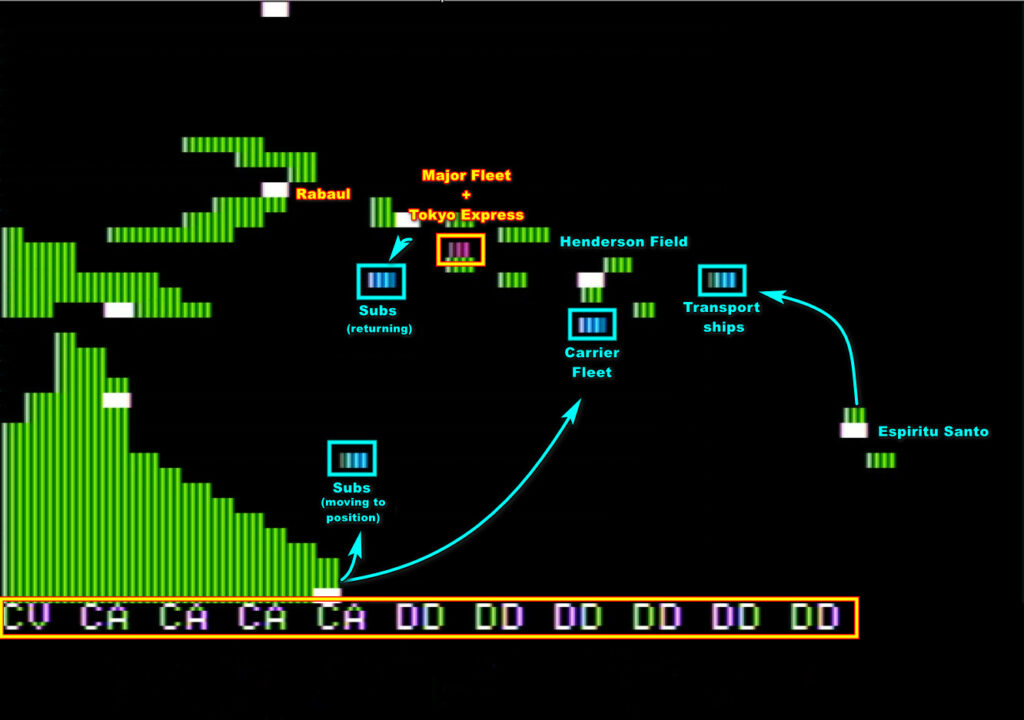
My pilots testified they saw a carrier, but it is more probably a battleship in a bombardment mission.
My suspicion is confirmed during the night :

I want to intercept the battleship on its way back – no way it survives attacks from three different aircraft carriers. I immediately move into position and …
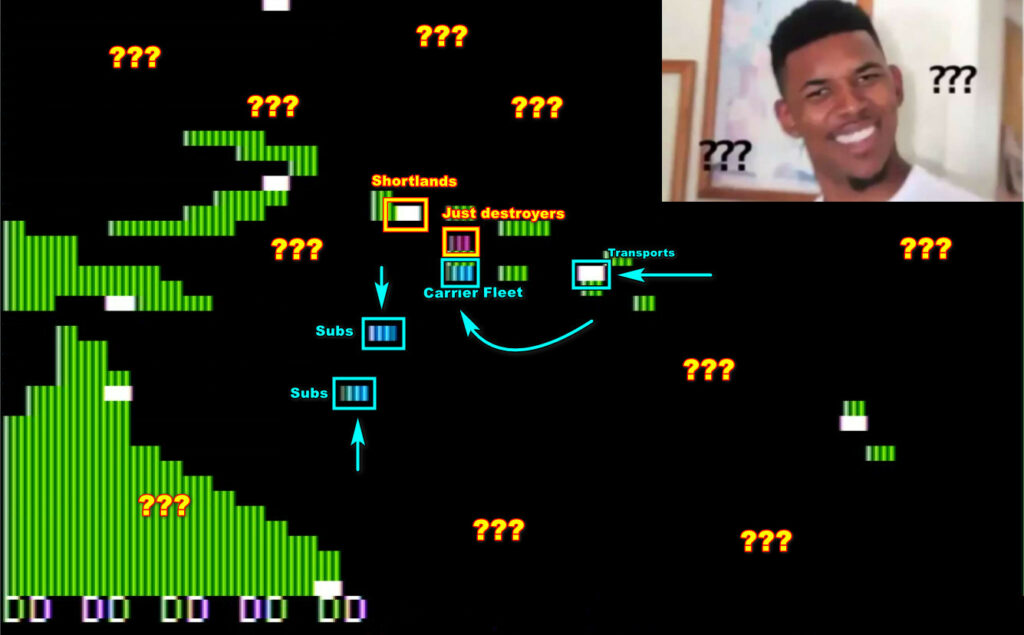
I find the Tokyo Express, but where is the battleship ?
I actually have no idea what happened. Either she returned full North rather than West, or my pilots missed her. The weather was “Heavily overcast”, and I was stingy in scout planes so I could have as many planes as possible allocated to my strike forces…
Well, those destroyers will pay for the missing battleship. The 5 destroyers receive 3 full strike forces !
But something changed : since the beginning of October, the Japanese have garrisoned the island of Shortlands, from which they can fly combat air patrol missions !

I lose maybe 10 bombers in total – not a lot but still attrition. As for the destroyers, I only sink 2 of them : the Shiratsuyu and the Yugiri. Two others are damaged.
As usual, Bettys from Rabaul counter-attack, and as usual, they are easily repulsed, but the fuel level of my carriers collapses.
I stick around for a couple more days, hoping to catch something – anything. But all I get to feed my pilots is a damaged destroyer trying to return home (the Sazanami), which is easily finished off.
On the evening of the 12, out of fuel and under constant Betty attack, I finally call off the mission. The three carriers return to Brisbane, which they will reach on the 16th. The most powerful US task force ever had only sunk 3 destroyers…
14th to 21th of October 1942 – Interlude
Not much happens in the middle of October – not that a lot happened in the beginning of October either. I realize the Japanese have landed quite a few people on Guadalcanal, but the new supplies that arrived during the botched carrier mission allow me to kill them all :


I need to keep the garrison constantly fed, and I use “fast transport” missions for this (3 days back-and-forth). Those missions are fast indeed (3 days back-and-forth using a direct route, compared to 6 days when I use a submarine-avoidance circuit, even with fast destroyers), but they are also risky and I lose the transport destroyer Little to a Japanese submarine.
One of my submarines also manages to badly damage a Japanese cruiser, though not to sink her :
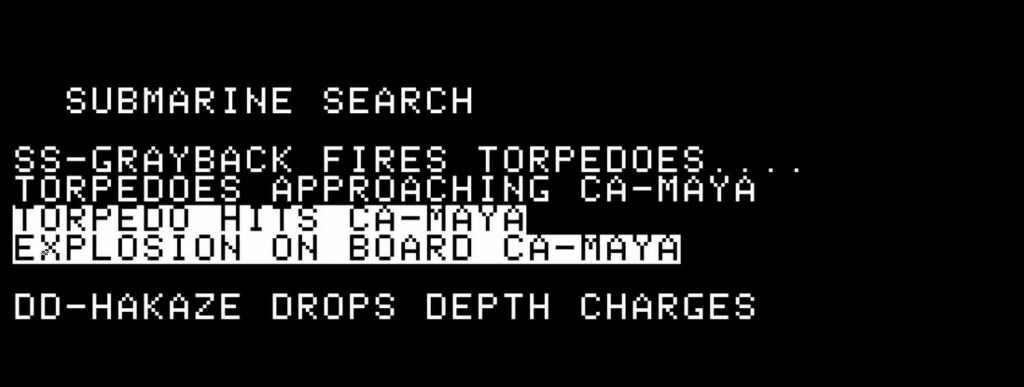
22nd to 31st of October 1942 – Battleship regained
On the evening of the 22nd of October, my carrier fleet is refitted and sent for the exact same kind of mission as earlier this month.
This time, I want to make sure I do not lose the Japanese fleet once detected. The surest way is to field a LOT of planes on Henderson Field, for recon purposes, and of course, this also means I need to prevent the Japanese from shelling the airfield.
Well, with the Yamato gone, I am confident in the superiority of my battleships over the Japanese remaining battleships, so let me introduce you to a new cog in my plan : Task Force Battleship !

This very powerful surface fleet will launch from Espiritu Santo and guard Guadalcanal, and I dare any Japanese fleet to approach that.
This is the situation the morning of 24th of October :
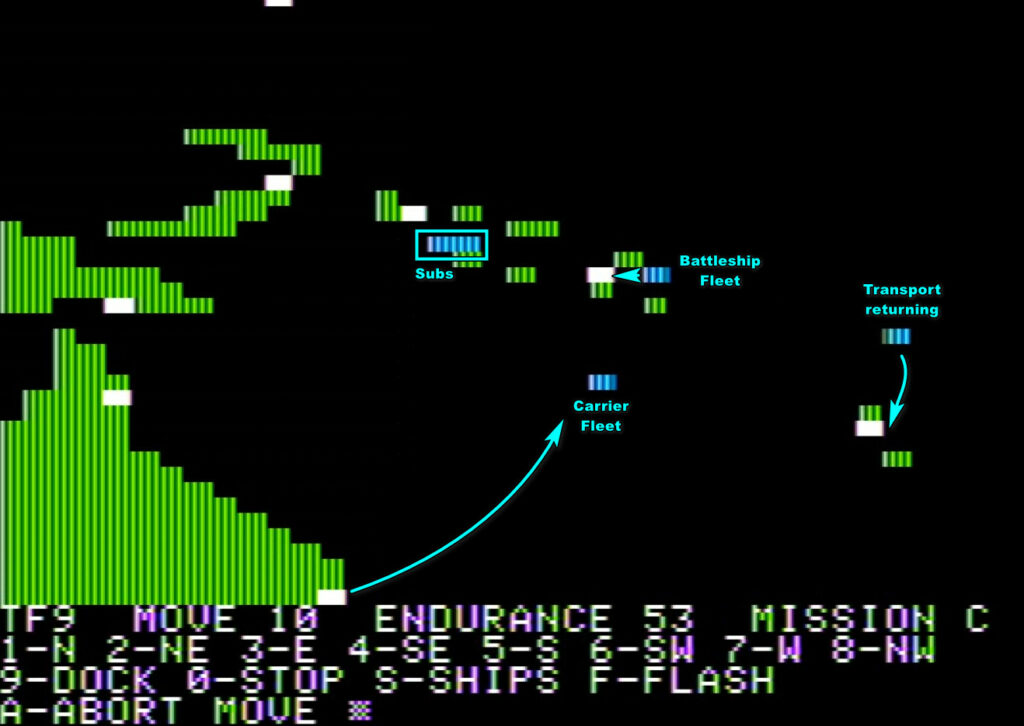
Task Force Battleship reaches Henderson Field during the night… where it immediately meets a Tokyo Express run. The US Navy shoots first, and does not give much of a chance to the Japanese. Two destroyers are immediately sunk :

I don’t want to move my carriers in range of Rabaul, but some of the Japanese destroyers are so damaged that they are still in range of Henderson Field the morning of the 25th, and mechanically :

That’s a good start, but my battleship fleet’s new fuel level is below 10 due to the attack, and therefore when the night comes, it is unable to intercept the Japanese bombardment mission :

Well, the damage is done, at least now I can attack the battleship, and I have enough planes left in Henderson Field to make sure I don’t lose the Japanese fleet this time.
And indeed, the 27th :

This time it is perfect. I send all my planes (except a few Wildcats in Combat Air Patrol above my carriers). I pay the attrition tax to the enemy fighters from Shortlands, and my bombers drive on the Japanese ships, landing a bunch of bombs on the battleship Hiei, the cruisers Myoko, Chokai, Yubari and Jintsu… but my torpedo bombers all miss ! Without torpedoes damaging the enemy’s hulls, the Japanese ships are not slowed down.
I have one more opportunity to catch the Hiei before she reaches Rabaul, and I follow her on the 28th :
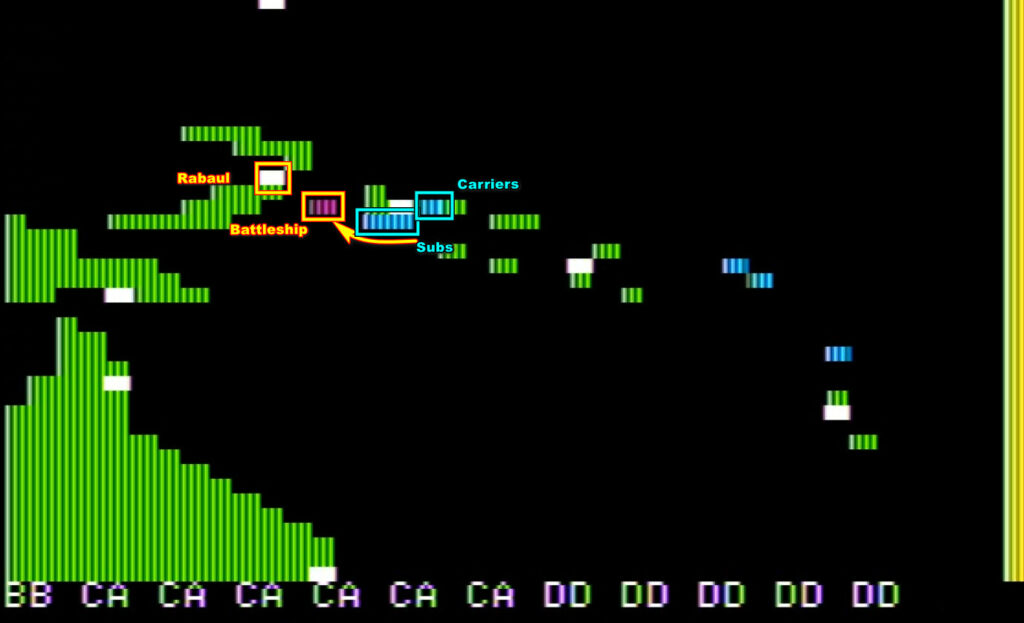
From this new position East of Shortlands, I attack once again the enemy fleet, paying the attrition tax once again. But the distance is too great and I only hit the Myoko twice more and the Jintsu once.
To add injury to the insult, I get so close to Rabaul that the few Bettys still able to fly manage to hit the Wasp !
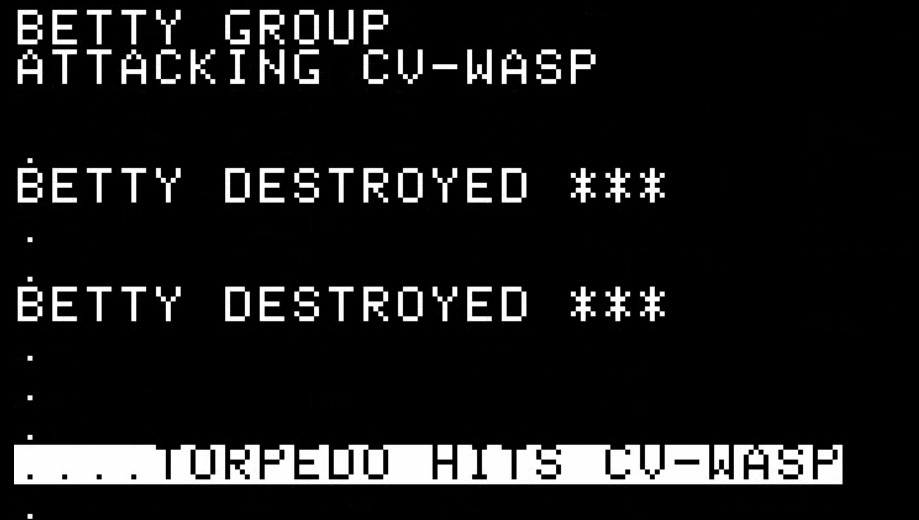
I have no choice but to return home. Meanwhile, I lose another destroyer to a submarine during a San Francisco Express :
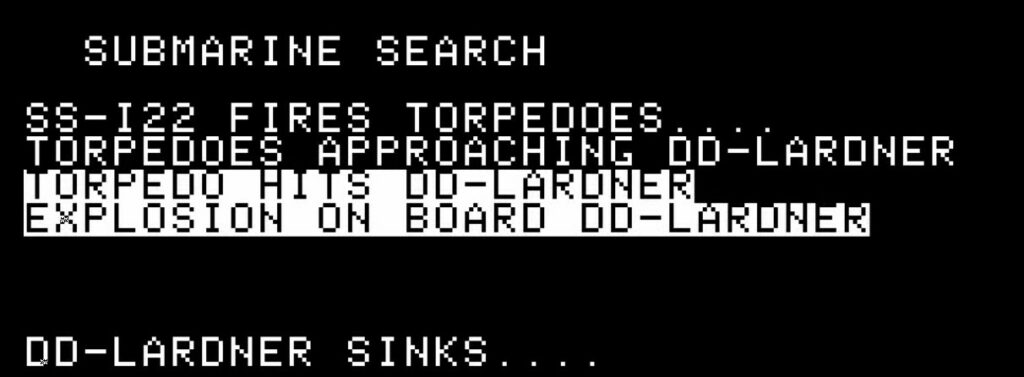
My carrier fleet reaches Brisbane on the 31st of October. I consolidate my air wings, so I could transfer a full load to the Enterprise, while the Hornet has 90% or so of a full load. Both the Saratoga and the Wasp are devoid of planes, and will need to train new pilots, but before that the Wasp will need 33 days of repair… At least, I don’t expect the Hiei and the Shokai to come back anytime soon either.
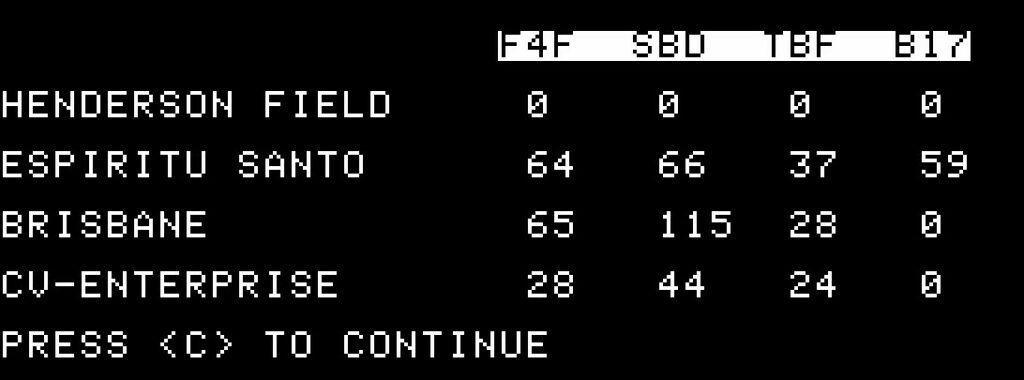
October was obviously a lost month. I had carriers and the Japanese did not, and despite this I only managed to sink 7 destroyers in total.

On the positive side, the Japanese have only two months left to take Guadalcanal (they declined to use their transports in October, possibly because they didn’t want to send them unescorted by carriers), and presently they have exactly 0 soldiers left on the island.
But I expect November to be tense : the Japanese will have two new carriers available to them (the Jun’yō and the Hiyō) and the Shōkaku is likely to be back. To counter that, I will only have the Enterprise, and later the Saratoga. The month of battleship-hunting and destroyer-bullying is over.
Next episode : November
Time played so far for the main campaign : 9 hours 35 minutes